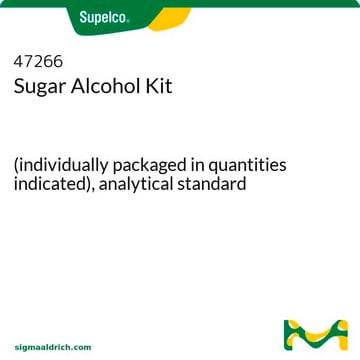W222216
Isobutyric acid
natural, ≥99%, FCC, FG
Sinónimos:
2-Methylpropionic acid
About This Item
Productos recomendados
grado
FG
Fragrance grade
Kosher
natural
Nivel de calidad
Agency
follows IFRA guidelines
meets purity specifications of JECFA
cumplimiento norm.
EU Regulation 1223/2009
EU Regulation 1334/2008 & 178/2002
FCC
FDA 21 CFR 117
FDA 21 CFR 172.515
densidad de vapor
3.04 (vs air)
presión de vapor
1.5 mmHg ( 20 °C)
Ensayo
≥99%
temp. de autoignición
824 °F
lim. expl.
10 %
características de los productos alternativos más sostenibles
Less Hazardous Chemical Syntheses
Use of Renewable Feedstocks
Learn more about the Principles of Green Chemistry.
sustainability
Greener Alternative Product
índice de refracción
n20/D 1.393 (lit.)
bp
153-154 °C (lit.)
mp
−47 °C (lit.)
densidad
0.95 g/mL at 25 °C (lit.)
aplicaciones
flavors and fragrances
Documentación
see Safety & Documentation for available documents
alérgeno alimentario
no known allergens
alérgeno de la fragancia
no known allergens
categoría alternativa más sostenible
Organoléptico
butter; acidic; rancid
cadena SMILES
CC(C)C(O)=O
InChI
1S/C4H8O2/c1-3(2)4(5)6/h3H,1-2H3,(H,5,6)
Clave InChI
KQNPFQTWMSNSAP-UHFFFAOYSA-N
¿Está buscando productos similares? Visita Guía de comparación de productos
Categorías relacionadas
Descripción general
Otras notas
Palabra de señalización
Danger
Frases de peligro
Consejos de prudencia
Clasificaciones de peligro
Acute Tox. 3 Dermal - Acute Tox. 4 Oral - Eye Dam. 1 - Flam. Liq. 3 - Skin Corr. 1B
Código de clase de almacenamiento
3 - Flammable liquids
Clase de riesgo para el agua (WGK)
WGK 1
Punto de inflamabilidad (°F)
131.0 °F - closed cup
Punto de inflamabilidad (°C)
55 °C - closed cup
Equipo de protección personal
Eyeshields, Faceshields, Gloves, type ABEK (EN14387) respirator filter
Elija entre una de las versiones más recientes:
¿Ya tiene este producto?
Encuentre la documentación para los productos que ha comprado recientemente en la Biblioteca de documentos.
Los clientes también vieron
Nuestro equipo de científicos tiene experiencia en todas las áreas de investigación: Ciencias de la vida, Ciencia de los materiales, Síntesis química, Cromatografía, Analítica y muchas otras.
Póngase en contacto con el Servicio técnico











